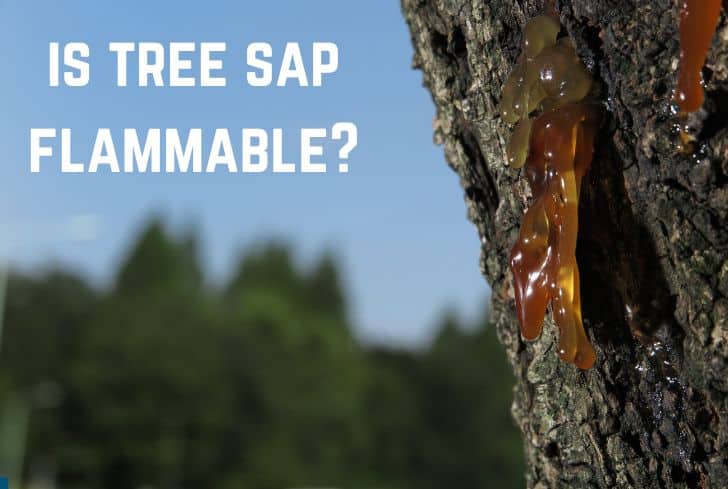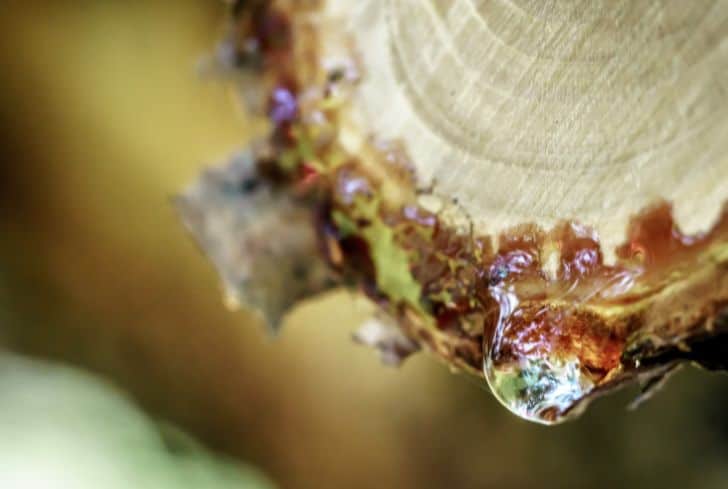Is Tree Sap Flammable? (And Pine Sap?)

Do you ever wonder about the source of the maple syrup you drizzle on your pancakes? Do you know the syrup you like comes from a tree’s sap? Maybe, you only associate tree sap with the sticky substance that gets on your clothes while bringing in a Christmas tree. Does it have other harmful characteristics besides sticking to your clothes and fingertips? Is tree sap flammable, for instance?
This article explains if pine sap is flammable and whether you can use it to start a fire. Additionally, we tell you how to test tree sap to know whether it is flammable or not. We’ll also let you know if burning sap is toxic and highlight some of the various use for sap.
What is Sap?
Tree sap is often known as the “blood” of a tree. It is composed of two elements. Water, hormones, nutrients, and minerals are transported up a tree’s trunk by the component xylem. The rings you typically observe on a tree stump are xylem channels, which correspond to one year of a tree stump.
The other component is the phloem, which has water-soluble minerals, hormones, and sugars. Phloem sap sends informational signals throughout vascular plants.
Tree sap is a sticky liquid that runs through the tree and down the branches. It helps to generate energy when new buds are forming. During the trees’ growth period, sugars form through photosynthesis. The tree uses sugars as food. Tree sap can also indicate whether the tree is healthy or not. When you notice tree sap leaking from the bark, it means pests or diseases have attacked the tree or the tree has suffered damage.
Weather changes may also be the cause of tree sap discharge. When the sap flows through the tree, it produces carbon dioxide. The pressure created by the carbon dioxide inside the tree may force the sap to ooze out of the tree. Warmer weather can also put pressure on the tree.
Is Pine Sap Flammable?
Most saps, including pine sap, are flammable. Pine sap contains both flammable gas and oil. Pine sap is likely to catch fire when exposed to a heat source. The sap will also ignite if exposed to temperatures that are too high. Pine sap, which is very flammable, can explode if left in open containers without being monitored.
Now you know why your campfire’s pine branches lit so quickly.
Because pine sap is highly flammable, it can ignite even when pine branches are just a little damp. Outside camping out in the woods, having sap can be a lifesaver for you. It just might keep igniting your moist wood. To help your wood burn a little faster, you can add some sap to it.
Why is Pine Sap Flammable?
Since it contains both oil and gas, pine sap is flammable. The oil will inevitably settle at the bottom if you collect pine sap in a jar. The top of the container will retain the flammable gas. In poorly sealed containers, flammable gases can accumulate and result in an explosion. Even though sap doesn’t have a flash point, it can catch fire as the temperature rises.
Pine sap is flammable for various reasons, including organic materials, gas, and oil. Sap’s stickiness makes it easy for flames to spread quickly. Sugars are highly concentrated in sap, making it highly flammable.
How To Test If Sap is Flammable or Not?
Using a piece of paper is the simplest way to determine whether the sap is flammable or not. Roll a piece of paper with some sap on it in your hands. The sap is flammable if the paper turns black. Another way to know is if the sap begins to crystallize as you brush it between your fingertips. Suppose a small quantity of smoke is produced when the crystals are broken, then the sap is flammable.
The sap you have is not flammable if the piece of paper does not become black. The sap is not flammable if smoke is not produced. The smoke demonstrates the trees’ capability for combustion and fire.

Can You Start a Fire With Pine Sap?
You can use pine sap to start a fire. Use pine sap to start a fire in one of the following three ways. Rub two pieces of pine bark together to create friction. It’s also possible to light pine sap with a match. You can pour sap on your pieces of wood and wait for the sun’s heat to ignite them if it’s during the day and the sun is hot.
Use the sap to start your campfire the next time you’re out camping and need to make a fire to cook over it or keep warm at night. The pine sap can also be used to create a flame-producing torch. A long stick should be cloth-wrapped at one end before dipping into the pine sap you have collected.
How To Use Pine Sap to Start a Fire?
You shouldn’t have trouble starting a fire, as the sap is a flammable substance. Here are the steps you can follow:
- Collecting pine sap is the first step.
- Look for a pine tree. Make a hole at an upward angle in the tree.
- Scrape the bark about six inches until you see pine sap. Ensure the sap looks clean. If the sap is another color, move on to the next pine tree.
- Use alcohol to sterilize your spout before inserting it correctly into the tree.
- Put a jar beneath the spout and start collecting the sap.
- Use a matchstick to ignite sap that has been poured where you want to start a fire.
Look at how easily you can do it:
Is Burning Tree Sap Toxic?
Although no proof burning sap releases poisons, the sap is nonetheless seen as toxic. Tree sap has organic chemical compounds known as Furanocoumarins. The sap is a natural defense mechanism for most plants against insects and mammals. When your skin is exposed to the sun, contact with the sap molecules on your skin triggers a reaction. Phytophotodermatitis is the medical term for skin reaction.
The main symptoms of Phytophotodermatitis are highlighted below:
- A burning sensation
- Itching
- Large areas of blistering
- Redness
- Inflammation
What Can Tree Sap Be Used For?
Don’t reject tree sap just because it stained your clothes after getting stuck on them. Tree sap has numerous uses and benefits. It will serve you well when you need to light a fire or make a torch. But you do the following using sap:
1. Natural antiseptic
Pine sap comprises lignans and natural acids that treat and cure wounds. It also consists of natural-antibacterial properties. Additionally, it has anti-inflammatory qualities; because it is sticky, you can use it to seal wounds. Some people have used it for treating eczema.
You can chew the softer sap to treat colds and sore throats.
2. Primitive lamp
Since tree saps are flammable, you can use them to make lamps. You can place a bit of sap inside a hollowed-out piece of wood. Put a tiny piece of cloth there to serve as a wick. Use a match to light the submerged piece of cloth; it should last a while.
3. Glue
Tree sap can be a strong glue since it’s sticky, strong, and water resistant. The only disadvantage with the tree sap glue is that it tends to dry out. You’ll have to heat it every time you want to use it, which can be messy. It can also be dangerous as the sap is flammable.
Learn how to make pine sap glue:
4. Torch
Wrap a long, thin piece of fabric around the end of the stick. Dip the fabric-covered stick in sap. You can use it as a torch for a while after lighting it up. Don’t hold the torch since the sap will drip down the stick and burn your hands. It would be safer to plant the stick in the ground.
5. Natural sweeteners
Sap from maple trees is used to make maple syrup. It is a popular sweetener for waffles, oatmeal, pancakes, and porridge. Alternatively, you can use it to glaze meat or drizzle it over desserts like ice cream and veggies. Some people also use it as an ingredient while baking cakes. Additionally, you can use it to make barbecue sauce.
Maple syrup has a thick and caramel-like taste with traces of vanilla wood. The type of tree, area, and harvest time all affect maple syrup’s flavor.
6. Drinking juice
One of the best juices to drink is from birch tree sap. It has a light syrup-like texture and is only slightly sweet. Amino acids, xylitol sugars, proteins, and enzymes are all found in birch tree sap. Additionally, it has detoxifying and therapeutic effects, as well as being beneficial for some body organs.
Frequently Asked Questions
1. Is Maple Syrup Flammable?
Despite being made from maple sap, maple syrup is not flammable due to its high water content. It has a 219°F boiling point. But maple tree sap is flammable. It comprises compounds such as vitamins, proteins, polysaccharides, and sugars. With a high sugar content, maple sap becomes highly flammable.
2. What Tree Sap is Poisonous?
The sap from the manchineel or beach apple tree is highly poisonous. The sap is milky white and contains several toxins that can burn your skin. Every tree component has sap, including leaves, fruits, and bark. The tree is primarily found in brackish swamps and on coastal beaches, where it grows among the mangroves.
Conclusion
Now that you know how to start a fire using pine sap, you can go camping confidently. Even when slightly moist, pine tree sap is flammable. You can also use tree sap as an antiseptic, glue, and food sweetener and drink it as a healthy juice.






